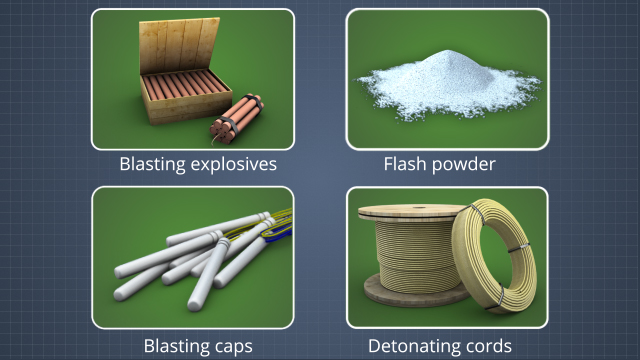




Commercial Explosives Safety
An explosion is a sudden, violent release of energy accompanied by the expansion of high-pressure gases. An explosive is any chemical compound, mixture, or device intended to create an explosion. This course discusses types of explosive materials and their UN (United Nations) hazard classifications. It reviews common explosion hazards as well as the recommended personal protective equipment. This course illustrates proper material handling, storage security, best practices for blasting operations, and explosives disposal.
Request a demoCourse Details
Learning Objectives
• State the definition of an explosion and an explosive • List examples of explosives • List the United Nations’ classifications of explosives • List common applications of commercial explosives • Describe common hazards of explosives • Describe common recommended PPE when handling explosives • List best practices for handling explosives • List best practices for explosive storage security • List best practices for blasting operations • Describe requirements for safe disposal of undetonated explosives
Specs
| Course Level | Intermediate |
| Languages | English |
| Compatibility | Audio, Video |
| Based on: | 30 CFR Part 46.5.b.4 |
Key Questions
What are the main hazards associated with working with explosives?
Working with explosives puts miners and others on-site at risk of injury from ejected material and blast concussion as a result of poor blast area security, premature blasts, misfires, and dangers related to the disposal of explosive material.
What is flyrock?
Material that is powerfully ejected after an explosion. Flyrock is a leading hazard associated with working with explosvies. It usually originates from a highwall face or bench top as a result of miscalculated explosive energy compared to the geomechanical strength and confinement characteristics of a rock mass.
What are some best practices for working with explosives safely?
To work safely with explosives, read and follow manufacturer instructions; become familiar with local geology in order to reduce flyrock-associated injuries; use specific-colored clothes and PPE for workers using explosives; hold off on explosive work during electrical storms; inspect the blast area before the blast and remove unused explosives; use radios for good communication; clear and secure the blast area before the explosion; and have blast shelters available.
What are some best practices for security with blast equipment and explosives?
Inspect and verify that each magazine is properly secured; confirm that inventories of explosives are recent and correct; properly secure and accompany all vehicles used to transport explosives; verify identify of all people working with explosives; conduct regular safety training meetings regarding explosives; and alert all workers about blasting activities.
Sample Video Transcript
Commercial explosives are specifically designed and intended to be used in commercial or industrial operations such as mining or construction demolition. The mining industry is the largest consumer of commercial explosives which it commonly uses to release metal ore, minerals, stone, or coal from the earth’s crust. Commercial explosives may also be used to alter landscapes for road and tunnel construction or to demolish unused buildings and decommissioned structures.
Additional Resources
- Global Security – www.globalsecurity.org
- Global Security Hazard Classification Code – http://www.globalsecurity.org/military/systems/munitions/explosives-class.htm
- Institute of Makers of Explosives (IME) – www.ime.org
- IME Members – https://www.ime.org/content/members
- Wikipedia – http://en.wikipedia.org
- Wikipedia Explosives Shipping Classification – https://en.wikipedia.org/wiki/Explosives_shipping_classification_system
Demos + Pricing
Learn more about our courses, get pricing, and see our platform.











